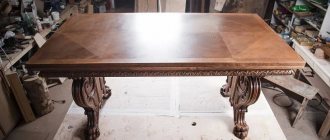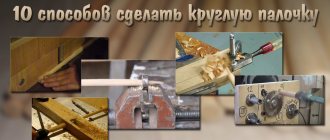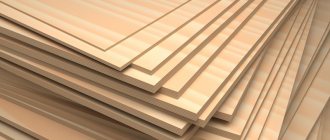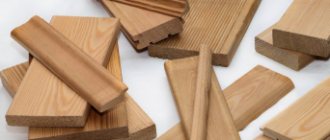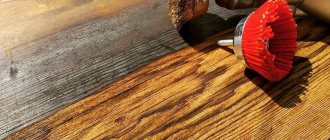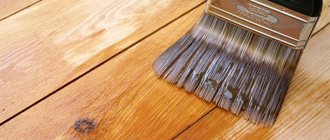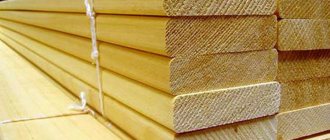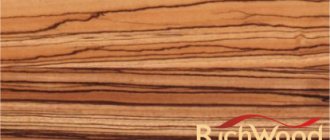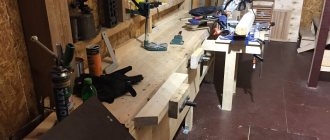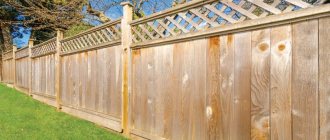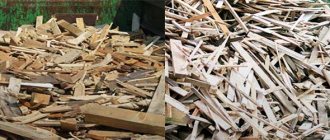How to choose a quality product
The Russian market is filled with counterfeit and low-quality products, so it is very important to choose the right slabs and blocks from wood chips and cement.
Therefore, we recommend paying attention to:
- appearance of the material;
- certificate of conformity;
- test report;
- reviews from those who already live in houses made from material from one manufacturer or another.
All products must be completely identical in size and shape; if at least one part differs in size and shape from the others, then it is better to refrain from purchasing. Most likely, this batch of products was manufactured using low-quality equipment.
Be sure to ask the seller or manager to show you the certificate of conformity and test report.
If these documents are not available, most likely you are looking at the products of one of the underground enterprises, so the composition and real characteristics of the blocks or slabs are unknown to anyone.
In addition, ask the seller or manager for the addresses and telephone numbers of those who have already purchased ShchtsP or ShchtsB from them.
Those who produce high-quality products never hide the coordinates of their clients, because their homes are the best advertisement for the company’s products. If they refuse to provide you with the addresses or telephone numbers of those who purchased the company’s products, then refuse the purchase.
Smoking kits
The costs of running a business producing sawdust for smoking will be minimal. In principle, they can be reduced to printing labels and packaging goods. Difficulties arise only with finding the necessary sawdust; deciduous trees are required, preferably fruit trees like cherry or pear, but aspen, alder and juniper will also work. Coniferous and birch ones are absolutely not suitable; they spoil the appearance of the dish and give it a bitter aftertaste.
The demand for such products is constantly growing, and more and more Russians are acquiring their own smokehouses. People unite in online communities of interests, where they can offer products.
Waste from wood processing enterprises is a valuable and multi-purpose material that has wide practical applications in the household. Wood shavings have many useful properties, as a result of which their processing can become a business that generates good income. At the same time, environmental and everyday human needs will be satisfied.
ShchtsB
The installation methods and suitable glue are also completely identical. However, due to the high cost of obtaining wood chips, conventional blocks are not widely used, which cannot be said about permanent formwork blocks.
They are a ready-made cell with outer and inner walls, as well as transverse partitions. Foam plastic is often glued to the inside of the outside, which holds there much more tightly than on permanent sheet formwork.
Indeed, in addition to the high strength of the block itself, the staggered laying also has an effect, due to which each piece of foam plastic is securely fixed with a jumper both on its own row and on the next one.
Durisol permanent formwork blocks are manufactured using the same technology as conventional wood concrete blocks, with the only exception being the shape of the matrix and punch.
Properly manufactured blocks are equipped with locks both on the top and bottom sides, as well as on the ends, so that when assembling the formwork, the individual parts are securely connected to each other.
Prices
We have prepared a table in which we included products from various manufacturers:
| Type and name of material | Dimensions (length, height, thickness in mm) | Price in rubles per unit | Manufacturer or seller | Manufacturer or seller website |
| Plates | ||||
| SV-35 | 2000x500x35 | 375 | SV-Invest | zsmsvinvest.ru |
| SV-U-135 (with foam) | 2000x500x35, thickness of foam plastic PBS-S-35 100 mm) | 826 | ||
| SV-35 | 2000x500x35 | 370 | Eco house | eko-dom123.ru |
| SV-P-105 (for partitions and internal walls) | 2000x500x105 | 1200 | ||
| SV-U-135 (with foam) | 2000x500x35, thickness of foam plastic PBS-S-35 100 mm) | 810 | ||
| WCS-35 | 2000x500x35 | 340 | PG-STROM Group, JSC | pgstrom.stroynet.ru |
| Blocks | Dimensions (length, height, thickness in mm) | Price in rubles per unit | Manufacturer or seller | Manufacturer or seller website |
| DM 22/15 | 500x250x220 | 145 | Dobrynya | dspb.ru |
| DMI 25/18 | 500x250x250 | 180 | ||
| DSs 30/15 EA | 500x250x300 foam thickness 5 cm | 300 | ||
| DM 22/15 | 500x250x220 | 138 | CityStroy SPB | opalubka-stroy-spb.ru |
| DM 25/18 U | 500x250x250 | 171 | ||
| DSs 30/15 EA | 500x250x300 foam thickness 5 cm | 285 | ||
| DM 25/18 | 500x250x250 | 140 | StroyOpt | pro100stroyka.ru |
| DSs 30/15 EA | 500x250x300 foam thickness 5 cm | 255 |
Several fertilizer recipes
Sawdust in its pure form is used only for filling paths in order to retain moisture and stop the development of weeds. In other cases, preparation of raw materials is required.
For sawdust in the garden to become useful, it needs to rot. To achieve the required condition, they will have to lie in a pile for at least 10 years while bacteria process the wood into a useful substrate. You can speed up the process by making compost from sawdust. In combination with manure and additional additives, the fertilizer matures faster due to thermoregulation in the desired range and maintaining a sufficient level of moisture.
We offer several recipes for preparing fertilizer from sawdust, which is used by gardeners throughout the country. It is recommended to bookmark from the beginning of summer as the necessary material becomes available.
Recipe 1: Wood and Ash
Stack:
- Wood sawdust – 200 kg;
- Urea, rich in nitrogen (up to 47%) – 2.5 kg per heap;
- Ash required to alkalize the soil – 10 kg;
- Water – 50 liters;
- Grass, food waste and sewage – up to 100 kg.
The shavings and grass are laid in layers, ash is added and the “pie” is filled with urea dissolved in water. You can cover the pile with polyethylene film, but small pores should remain on the surface: this way the temperature and humidity level will be optimal, and oxygen access will remain.
Recipe 2: Organically Enriched
For poor soil that requires a significant dose of fertilizer, prepare the following compost from sawdust:
- Wood waste – 200 kg;
- Cow dung – 50 kg;
- Fresh cut grass – 100 kg;
- Organic waste (food, feces) – 30 kg;
- Humates – 1 drop per 100 liters of water (no more).
When this fertilizer ripens, a significant amount of nitrogen is released.
Fresh sawdust fertilizer
As already mentioned, fresh sawdust does not benefit the soil as a fertilizer for the garden. If you have not done composting in advance, but it is necessary to saturate the soil, use a sawdust mixture with the following additives on a bucket of wood chips:
- Ammonium nitrate – 40 g;
- Granulated superphosphate – 30 g;
- Slaked lime – 120 g (glass);
- Calcium chloride – 10 g.
The mixture must be infused for 2 weeks. To do this, spread plastic outside and scatter the ingredients on it.
Mix and leave to release the necessary elements and carry out chemical reactions. After this, add the resulting mixture to the soil when digging the beds. The soil will receive a sufficient dose of ammonia, the acid-base balance of the soil will be leveled, and the release of useful substances will occur immediately after the first watering. The soil should be fertilized in the amount of 2-3 buckets per 1 square meter of land. This procedure promotes natural loosening of the soil.
Storing vegetables
Sawdust is a popular insulation material used for storing vegetables indoors or on the balcony. This helps maintain optimal temperature and minimizes moisture evaporation, which serves as the prevention of fungal diseases.
Storing root vegetables in sawdust is very simple: pour a layer of wood shavings 2-3 cm thick into a box and lay the fruits on it so that they do not touch each other. After which they are covered with a layer of sawdust. Alternating vegetables and shavings, completely fill the container.
For storage, you can take both wooden boxes and cardboard boxes. Well-dried sawdust keeps the fruits fresh for a long time, and also makes it easy to take them out of the box and wash them.
Comparison with other types of materials for creating permanent formwork
The main competitors of ShchCP Velox in the creation of permanent formwork are:
- DSP;
- Styrofoam;
- glass magnesite sheet (GML);
- Durisol blocks.
If we compare SCP and CBPB, then both materials are the same in all main characteristics, because the only difference between them is the size of wood waste.
The exception is chip-cement slabs made with the addition of liquid glass - they are much inferior in vapor permeability, which is why the walls of the house stop transporting excess moisture to the street. Adding polystyrene foam makes this situation worse, causing the home's ventilation requirements to skyrocket.
The main advantage of polystyrene foam is its low price and good thermal insulation properties, however, due to its low strength, such formwork must be sheathed with some kind of sheets, at least from the inside.
SML is somewhat denser than ShchCP, and is also supplied in sheets 2–2.5 m long and 1.2–1.25 m wide, so it is noticeably more difficult to work with. In addition, you will have to use not only overhead fasteners, but also fasten them with through ties, which, after the concrete has hardened, will have to be covered with additional finishing, because if they are cut, there is a high probability of the LSU peeling off from the concrete.
Despite the fact that Durisol blocks are made of the same material as Velox slabs, their application and influence on the speed, and often the result of construction, are very different.
Finished blocks do not need fixing jumpers, because they themselves are such jumpers.
In addition, peeling off the foam glued into them does not lead to problems, because it is securely pressed on all sides.
Therefore, the construction of Durisol formwork requires much less time and materials. At the same time, in terms of the main operational characteristics, Velox slabs and Durisol blocks are completely identical, because they are made of the same material.
Other concrete panel options
In addition to traditional concrete with a cement binder, other types of concrete are made from chips:
- plaster;
- clay;
- lime.
However, their load-bearing capacity is much lower than that provided by the use of cement. Therefore, alternative types of chip concrete are used only as insulation material. Another difference is the absence of sand, because sand increases the strength of cement stone, but has little effect on other types of binders.
In addition, alternative types of chip concrete are highly sensitive to moisture and water, so they can be used either indoors (insulation of floors and ceilings) or covered with a very high-quality finish that provides maximum protection from precipitation.
Natural flavor
The excellent absorbent properties of wood chips make it possible to use it as a fragrant sachet. There are two manufacturing options:
- Sawdust from pine or juniper is poured into a fabric bag and tied tightly with a ribbon.
- Shavings of any type of wood are soaked in essential oil and poured into a container or bag, tied or covered with a lid.
The natural fragrance can be placed in the closet where clothes and linens are stored, or in the room and enjoy the pleasant aroma.
Calculation of the necessary materials for preparing blocks from shavings and concrete
To obtain high-quality concrete, it is important to observe not only the proportions of the initial components, but also the entire procedure, otherwise the strength of the material will be lower than expected. Also, violation of the procedure will lead to an increase in the ability to absorb water, which will reduce the service life of the concrete structure.
Here is the procedure that is applicable for preparing chip concrete for any purpose:
- Dissolve freshly slaked lime in water (1 kg per 20 liters of water) and soak the shavings in this milk. Soak small chips (thickness 0.1 mm or less) for 24 hours, medium chips (thickness over 0.2 mm) for 48 hours, large chips (thickness 0.4 mm or more) for 72 hours.
- In a concrete mixer, mix cement, sand and quicklime in the required proportions.
- Catch the shavings from the container with lime milk and let drain for 10–15 minutes, then pour the required amount into a concrete mixer and mix thoroughly.
- Prepare the water by adding a superplasticizer to it in an amount ¼ of that recommended in the instructions for it. You also need to add hydrophobic additives, for example, Siloxyl (instructions for use on the package). If you are making insulated concrete, also add wood resin foam or another air-entraining additive (a foam generator will be required). In this case, act strictly according to the instructions on the reagent packaging.
- Add the required amount of water (take into account the moisture content of the sand and the milk of lime in the shavings, so reduce the amount of water by 2-5%) and mix thoroughly.
- Distribute the concrete into the forms.
- If you didn’t manage to use all the concrete in 5 minutes, mix again.
Here is the calculation of materials for the manufacture of concrete particle boards for various purposes:
| Number of components in kg (for water in liters) | |||||
| Purpose | Cement | Sand | Lime | Shavings | Water |
| Warming | 10 (M400) | 2 | 8 | 100 | 3 |
| Insulating and for non-load-bearing walls of non-residential buildings | 10 (M400) | 10 | 10 | 100 | 3 |
| Load-bearing walls of non-residential structures or non-load-bearing walls of residential | 20 (M500) | 50 | 20 | 100 | 9,5 |
| Load-bearing walls of residential one-story houses | 40 (M500) | 100 | 50 | 100 | 20 |
| Load-bearing walls of two-story houses | 40 (M500) | 100 | 50 | 50 | 19 |
Euro firewood and pellets
Heating is a constant expense in our natural area. Not all settlements located far from large cities are connected to gas, a cheap and convenient source of energy. A significant portion of people are forced to continue to use solid fuel heating systems. An alternative to firewood in such a situation are fuel briquettes and pellets pressed from sawdust in production. Euro firewood, as they are also called, has a long burning time, they are easy to store, compact - 1 kg of this fuel takes up much less space than 1 kg of firewood. To top it off, briquettes and pellets are more technologically advanced and optimized for use in heating boilers with automatic loading.
You can make Euro firewood from sawdust with your own hands by building a press for it using a car jack. However, the quality of the finished product directly depends on the parameters of the production unit, i.e. if they base a business on this, they must buy equipment, the total cost of which will be from several hundred thousand to several million rubles.
Frequent manufacturing errors
Negative reviews about chip concrete that can be found on the Internet are most often associated with mistakes made during the preparation or use of this material.
Next we will talk about the most common of them.
Ignoring superplasticizers and hydrophobic additives
Quite often, users ignore and do not use superplasticizers.
These substances reduce the amount of water required to create a solution of the required viscosity, thereby increasing the strength of hardened concrete.
The addition of superplasticizers is desirable when pouring blocks, because it increases their strength, and is necessary when pouring monolithic walls.
Concrete with this additive is more plastic and fills the formwork more easily with the same amount of water.
By ignoring hydrophobic additives, the amount of moisture that enters the wood increases, so even filling the pores with minerals cannot reduce water absorption to a safe level. Often they refuse additives because they are afraid of reducing vapor permeability, but they do not affect this parameter.
Steam moves through the particles of cement stone at a very low speed, so the vapor permeability of chip concrete is always lower than this parameter of wood and is on the same level as brick or concrete. The addition of hydrophobic additives reduces vapor permeability by 2–5%, so it does not have any serious effect.
Selecting chips and neglecting to soak them
A common omission is also the incorrect choice of chip type. It is a mistake to use shavings from “sweet” wood species. Such species include birch, maple, willow, alder, and fruit trees.
Lime partially neutralizes the negative effects of sugars, but there is too much glucose in sweet rocks. But conifers contain little sugar and lime almost completely blocks this negative effect.
In addition, the shavings are not pre-soaked in lime milk. This operation is not performed to disinfect wood waste, its purpose is to fill the pores with minerals, due to which the wood’s ability to absorb water is reduced, and therefore increases:
- concrete strength;
- load bearing capacity;
- life time.
Sand and water
It is also a mistake to use smooth, fine sand.
The larger the sand and the more uneven the shape of each grain of sand, the harder it is to work with, but also the higher the strength of concrete. After all, cement laitance quickly slides off smooth sand, while on an uneven surface it lingers until it hardens.
And an increase in the amount of water makes concrete more convenient to work with, but weakens the cement stone, as a result of which the strength of the block or wall decreases.
Neglect of wood resin foam
For insulating boards, a decrease in the thermal conductivity of cement stone is more important than a certain loss of strength due to the transformation of cement stone into an analogue of a sponge, because these boards are not used as load-bearing elements.
The addition of foam and other reagents increases the thermal insulation properties of the slab by 5–15%, which brings its thermal efficiency closer to mineral wool and polystyrene foam.
Poor quality exterior finishing
It is very important not to forget about high-quality external finishing of chip concrete. Adding hydrophobic additives and filling the channels with minerals reduces the sensitivity of wood to water vapor, but contact with water produces too much moisture, which saturates the concrete and causes wood waste to expand
When transitioning from a liquid to a solid state, the volume of water increases by 11%, so the higher the humidity before the onset of frost, the stronger the impact on the cement stone when the water freezes inside the wood.
Bedding for animals
Soft shavings are a popular cat litter, as well as bedding for a variety of animals, from parrots and hamsters to cows and horses. Among the types of wood here, as a rule, the choice is something like poplar, aspen or apple tree. These species do not contain a large amount of resin, like conifers, and their sawdust contains fewer sharp splinters that injure the animal’s paws.
Pet owners note the ability of sawdust to quickly absorb moisture and muffle the smell of sewage. Sawdust helps create an antimicrobial environment in animal habitats, which helps animals stay healthy longer. Unfortunately, sawdust in its natural form is a very light material; small pets scatter it outside their terrariums and cages even unintentionally, which is why compressed pellets are sold on the market. They are more convenient to use, but their production requires special equipment.
When organizing such a pet business, the main efforts will most likely go into creating a new brand, promoting it and organizing sales through a network of shops and market stalls. The profitability of the business is high, because in this case sawdust can be sold at a price of more than 100 rubles. per kg.
ShtsP
These materials are made from wood concrete, often adding liquid glass to it. In most cases, the density of the finished slab does not exceed 800 kg/m3, due to which it has high thermal insulation properties and good strength.
Because wood chips are much thicker than shavings, it is difficult to make thin sheets from them, so in most cases the minimum thickness is 35 mm. This is too much for exterior or interior decoration, but ideal for permanent formwork.
The Velox company was the first to produce and use such slabs in the mid-twentieth century, so since then the slabs intended for external formwork have been called that.
Due to the use of natural coniferous wood chips, the company widely advertised its products as a new word in construction and an environmentally friendly material that is safe in all respects.
Some manufacturers glue insulation to the slabs, but this design causes many complaints from builders.
After all, manufacturers use cheap glues, or even just cement laitance, so reliable gluing does not work.
As a result, over time, foam plastic or other insulation moves away from the slab and the formwork, which does not have direct contact with the concrete, begins to move, which leads to the appearance of cracks in the finish and drafts.
For this reason, to create permanent formwork, material with a thickness of 60–85 mm is often used, because when such slabs are installed on both sides of the wall, their overall thermal conductivity is comparable to 10 cm thick foam plastic.
Such a wall will be more than sufficient even in the northern regions, with the exception of the Far North, but there the thickness of the wall can be increased by 1.2–1.5 times.
With sufficient thickness (usually 60–80 mm), such slabs can be used as partitions and internal walls. Their use in this capacity is completely identical to the use of CBPB, because the only difference between these materials is the method of producing wood filler and its size.
The technology for manufacturing chip-cement slabs is completely identical to that used in the production of CBPB.
The only exception is the method of obtaining wood filler.
For cement-bonded particle boards, waste from machine planing of wood is used, and for chip-cement parts, the filler is made on chipping machines or special shredders.
Find more detailed information about such equipment in these articles:
- Production of wood chips;
- Chip cutters.
Sawdust in production
There are several options for using such waste:
- Creation of building materials;
- New types of biofuels.
The first to add to the list of useful products made from sawdust is wood concrete (sawdust concrete). It contains cement, sawdust and special chemicals. This solution contains more than 70% wood waste.
Areas of application of wood concrete slabs:
- When building houses, as load-bearing interior partitions;
- When carrying out soundproofing and insulation work.
Advantages:
- Low cost;
- Strength of the material;
- Light weight.
Application of concrete particle boards
Due to its low compressive strength, this material is not used to create load-bearing walls of multi-story buildings. Even two-story construction is permissible only with wooden floors, and even then, the material will have low thermal insulation properties.
However, this material is used for:
- creating walls of low-rise buildings with low load;
- insulation;
- filling the space between reinforced concrete load-bearing columns.
Creating walls of low-rise buildings
Despite the fact that GOST R 54854-2011 does not allow the use of chip concrete for the construction of residential buildings, houses made from it have been standing for many decades, and it has been used for the construction of outbuildings since the middle of the last century.
This period is sufficient to conclude that if:
- correct selection of components;
- competent drafting of the project;
- correctly selected finish;
- compliance with technology,
houses with a height of 1–2 floors are quite durable and warm.
However, it is advisable to install such houses only in regions with:
- stable climate;
- little precipitation;
- slight differences in daily temperatures.
Violation of any of these points will shorten the life of the walls. An unstable climate, as well as heavy rainfall, means sharp changes in air humidity, and therefore in the moisture content of wood in the composition of chip concrete.
Changes in chip size caused by changes in humidity lead to changes in the size of wood waste. When wood fills with water and increases in size, it easily destroys the cement stone, which leads to weakening of the chip concrete.
To do this, liquid glass and other hydrophobic additives are added to the concrete composition, which prevent the absorption of water by wood, thereby reducing the amplitude of changes caused by moisture swelling and shrinkage of wood.
Insulation
For insulation, a material with a minimum content of cement and sand is used; in addition, it does not experience the loads that are carried by blocks of wood shavings and concrete in load-bearing walls.
Therefore, a slight decrease in strength caused by swelling and shrinkage of chips does not affect the thermal insulation ability.
Such insulation cannot be left open, because it strongly absorbs moisture not only from rain, but also from the air.
The addition of liquid glass does not affect the thermal insulation properties, but reduces the ability of chip concrete to transport moisture from the walls to the atmosphere, reducing it in this parameter to the level of clay brick.
Filling the space between reinforced concrete columns
In frame houses with reinforced concrete columns, different types of lightweight concrete, including chip concrete, are used to fill the space between the columns. In terms of thermal insulation abilities with equal density, only polystyrene concrete surpasses it, and other types of lightweight concrete are similar or inferior to chip concrete.
However, even in warm regions, such houses need insulation, because the thermal conductivity of reinforced concrete is very high, so without insulation, cold bridges will appear in place of the load-bearing columns.
Growing substrate
Due to its ability to loosen the soil, which means delivering more oxygen to the roots and filling it with nutrients, sawdust is often added to the substrate. For this purpose, it is better to take rotted sawdust or add urea to fresh ones to protect the plants from nitrogen deficiency.
A thin layer of wood shavings is poured into the prepared container and the seeds are placed. Cover the container with film and place it in a dry, dark place until the first shoots appear. Then they are transferred to a bright room, and a layer of fertile soil is poured onto the sawdust.
